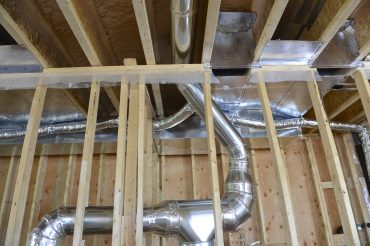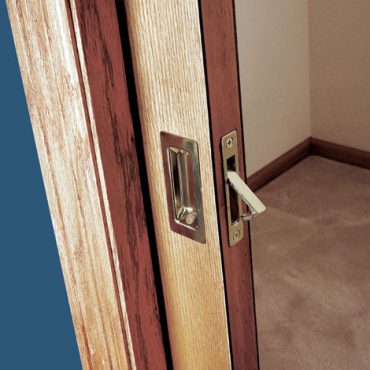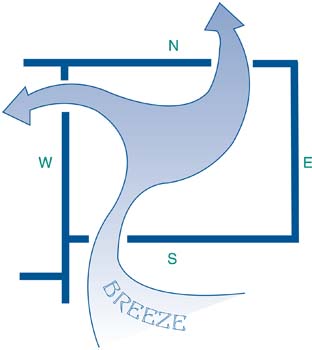
John Bleasby
Before the studs go up: 10 things for clients to consider
Canadian ContractorA little forethought now means a better house for years
If you are a builder or renovator with several projects under your belt, you may already have a checklist of design details to review with your clients. After all, not every client has experienced a new build or renovation before like you have; they count on you to offer some solid advice.
Some ideas can be dealt with during the design stage while others can be discussed later, but after the studs go up, well, it may be more difficult. I’m only going to throw out a few things here. However, I hope you will take some time and perhaps add a few of your own in the comment section at the end.
-

Despite radiant floor heating in this home, ducting was required for ventilation. Bringing the HVAC team in early means a simpler install
Bring in the HPAC team early.
No matter how the house is heated (natural gas or otherwise), cooled, or plumbed, there will be ducts and pipes. Engaging your HPAC team (Heating, Piping, and Air Conditioning) as early as possible gives them a chance to offer their expertise on how to reduce or even eliminate intrusive wall and ceiling bulkheads. Fewer curves, bends and right angles in a venting system, for example, means more efficient airflow. Lining up gas lines, water supply lines, and drains with the joist and stud structure in advance will reduce complexities and save time later on. There’s nothing more frustrating than finding a toilet, as drawn on the plan, is in fact directly over top a floor joist!
- Allow sufficient width in hallways and doorways for wheelchairs and walkers
Maybe not today but perhaps in the future, accessibility will become an issue.
-

Just an inch or two added to doorways will increase the home’s accessibility should it be required in the future….and it likely will be!
Eliminate raised thresholds at doorways for easier access
If different flooring materials are going to be used, allow for it when selecting sub-floor thicknesses. Floor vacuums roll better, not just walkers and wheelchairs, when there are no bumps at every entry.
- Check the swing of interior doors
Do a mock walk-through to see if the door-swings make sense. Check clearances on walls behind the doors to ensure they don’t overlap any others.
-

Personally, I’ve had it with fiddly latches and finger handles on closet pocket doors!
Reality check: few people actually close their pocket doors, especially on closets!
Pocket doors are heavier and more fiddly to operate than swing doors, not to mention more expensive to install. The result? They stay open most of the time, especially on walk-in closets.
- Make it a laundry room, not a laundry closet
It’s quieter and less obtrusive. Room or closet, try to locate the machines near the bedroom where the dirty laundry originates and later returns clean. If the laundry will be in the basement, check the legality and any restrictions of a laundry chute in your area.
- Got cats? Consider the litter!
Plan a corner for the kitty litter, maybe at the foot of the basement stairs or at least away from major traffic and out of sight; and use an easy-to clean floor surface. Add a cabinet or shelf for storage of replacement litter and clean-up bags.
- Centralise the mechanical
Plan a centrally located mechanical room in the basement for the HRV, heating system, water pump, sump pump, water filter system, main circuit panel, gas controls, and central basement floor drainage. Allow space for maintenance around the equipment, and good lighting.
-

Natural cross ventilation design is relatively easy, and does not require dozens of opening windows
How many opening windows do you really need for good cross-ventilation?
Not as many as you might think. A few well-placed opening windows and doors with screens will give the house natural, passive ventilation. An entire wall of expensive operating casements or awning windows is not required.
- Consider a door into a tiled ‘mudroom’ area directly from the garage.
It shortens the haul for groceries, is safer in winter than slithering across exterior walkways, and keeps everyday footwear and outerwear away from the front entrance, so guests can be greeted in style.
Got some pre-stud ideas of your own?
Share them with us!
follow John on Twitter @john_bleasby
Advertisement
Print this page

WHAT THE HECK IS HPAC TEAM? HVAC!!!
Heat, piping, air conditioning. Annex Business Media (our publishers) have an entire magazine devoted to this. Look it up sometime; it’s called HPAC. You can use the term HVAC if it makes you feel better, but then you’d be leaving out the piping for plumbing etc., and the point is to bring all these people into the project early so studs, joists etc. can be planned with them in mind too.
OK THANKS WE FIXED IT!!!